July in preprints
Posted by the Node, on 4 August 2020
Welcome to our monthly trawl for developmental biology (and related) preprints.
This month features a host of preprints on human development at the single cell level (perhaps all submitted in time for Development’s September meeting?), plus insights into how butterflies make clear wings and how worms achieve meiosis, and a whole lot more. Preprints hosted on bioRxiv and arXiv – use these links to get to the section you want.
Developmental biology
| Stem cells, regeneration & disease modelling
Evo-devo & evo
Cell biology
Modelling
Tools & resources
Research practice & education
Developmental biology
| Patterning & signalling
Fgf/Ets signalling in Xenopus ectoderm initiates neural induction and patterning in an autonomous and paracrine manners
Ikuko Hongo, Harumasa Okamoto
FGF signaling in development beyond canonical pathways
Ayan T. Ray, Pierre Mazot, J. Richard Brewer, Catarina Catela, Colin J. Dinsmore, Philippe Soriano
Notch controls arterialization by regulating the cell cycle and not differentiation
Wen Luo, Irene Garcia-Gonzalez, Macarena Fernandez-Chacon, Veronica Casquero-Garcia, Rui Benedito

Asymmetric neurogenic commitment of retinal progenitors is regulated via the Notch endocytic pathway
Elisa Nerli, Mauricio Rocha-Martins, Caren Norden

Notch-Directed Germ Cell Proliferation Is Mediated by Proteoglycan-Dependent Transcription
Sandeep Gopal, Aqilah Amran, Andre Elton, Leelee Ng, Roger Pocock
Tissue-resident macrophages regulate lymphatic vessel growth and patterning in the developing heart
Thomas J. Cahill, Xin Sun, Christophe Ravaud, Cristina Villa del Campo, Konstantinos Klaourakis, Irina-Elena Lupu, Allegra M. Lord, Cathy Browne, Sten Eirik W. Jacobsen, David R. Greaves, David G. Jackson, Sally A. Cowley, William James, Robin P. Choudhury, Joaquim Miguel Vieira, Paul R. Riley
Pericytes Directly Communicate with Emerging Endothelial Cells During Vasculogenesis
Laura Beth Payne, Bhanu Tewari, Logan Dunkenberger, Samantha Bond, Alyssa Savelli, Jordan Darden, Huaning Zhao, Michael Powell, Kenneth Oestreich, Harald Sontheimer, Sophie Dal-Pra, John C. Chappell
Circadian timing-dependent myoblast differentiation and muscle regeneration
Nobuko Katoku-Kikyo, Ellen Paatela, Daniel L. Houtz, Britney Lee, Dane Munson, Xuerui Wang, Mohammed Hussein, Jasmeet Bhatia, Seunghyun Lim, Ce Yuan, Yoko Asakura, Atsushi Asakura, Nobuaki Kikyo
An endogenous scaling mechanism in zebrafish appendages that controls two-pore potassium-leak channel activity to regulate morphogen and growth factor transcription
Chao Yi, Tim WGM Spitters, Ezz Al-Din Ahmed Al-Far, Sen Wang, Simian Cai, Xin Yan, Kaomei Guan, Michael Wagner, Ali El-Armouche, Christopher L. Antos
Variability of an early developmental cell population underlies stochastic laterality defects
Roberto Moreno-Ayala, Pedro Olivares-Chauvet, Ronny Schäfer, Jan Philipp Junker
Characterizing the diverse cells that associate with the developing commissures of the zebrafish forebrain
J. Schnabl, M.P.H. Litz, C. Schneider, N. PenkoffLidbeck, S. Bashiruddin, M.S. Schwartz, K. Alligood, M.J.F. Barresi
Programmed cell senescence in the mouse developing spinal cord and notochord
Jorge Antolio Domínguez-Bautista, Pilar Sarah Acevo-Rodríguez, Susana Castro-Obregón

Incoherent feedforward regulation via Sox9 and Erk underpins mouse tracheal cartilage development
Takuya Yoshida, Michiyuki Matsuda, Tsuyoshi Hirashima
The neocortical progenitor specification program is established through combined modulation of SHH and FGF signaling
Odessa R. Yabut, Hui-Xuan Ng, Keejung Yoon, Jessica C. Arela, Thomas Ngo, Samuel J. Pleasure
Expression of Wnt5a defines the major progenitors of fetal and adult Leydig cells
Herta Ademi, Isabelle Stévant, Chris M Rands, Béatrice Conne, Serge Nef
CAMSAP3 is required for mTORC1-dependent ependymal cell growth and lateral ventricle shaping in mouse brains
Toshiya Kimura, Hiroko Saito, Miwa Kawasaki, Masatoshi Takeichi
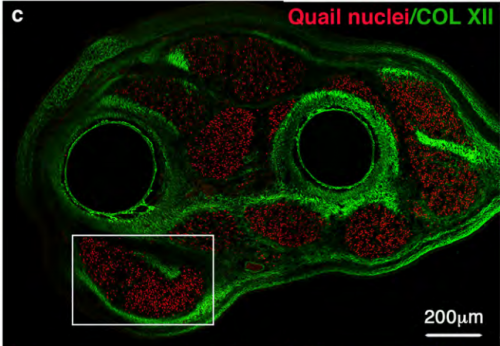
BMP signalling directs a fibroblast-to-myoblast conversion at the connective tissue/muscle interface to pattern limb muscles
Joana Esteves de Lima, Cédrine Blavet, Marie-Ange Bonnin, Estelle Hirsinger, Glenda Comai, Laurent Yvernogeau, Léa Bellenger, Sébastien Mella, Sonya Nassari, Catherine Robin, Ronen Schweitzer, Claire Fournier-Thibault, Shahragim Tajbakhsh, Frédéric Relaix, Delphine Duprez
Intraneuronal chloride accumulation via NKCC1 is not essential for hippocampal network development in vivo
Jürgen Graf, Chuanqiang Zhang, Stephan Lawrence Marguet, Tanja Herrmann, Tom Flossmann, Robin Hinsch, Vahid Rahmati, Madlen Guenther, Christiane Frahm, Anja Urbach, Ricardo Melo Neves, Otto W. Witte, Stefan J. Kiebel, Dirk Isbrandt, Christian A. Hübner, Knut Holthoff, Knut Kirmse
Astrocyte-neuron crosstalk through Hedgehog signaling mediates cortical circuit assembly
Yajun Xie, Aaron T. Kuan, Wengang Wang, Zachary T. Herbert, Olivia Mosto, Olubusola Olukoya, Manal Adam, Steve Vu, Minsu Kim, Nicolás Gómez, Diana Tran, Claire Charpentier, Ingie Sorour, Michael Y. Tolstorukov, Bernardo L. Sabatini, Wei-Chung Allen Lee, Corey C. Harwell
Intrauterine growth restriction causes cellular, molecular, and behavioral deficits consistent with abnormal dentate gyrus neurogenesis in mice
Ashley S. Brown, Matthew Wieben, Shelby Murdock, Jill Chang, Maria Dizon, Richard I. Dorsky, Camille M. Fung
Intrinsic neuronal activity during migration controls the recruitment of specific interneuron subtypes in the postnatal mouse olfactory bulb
Bugeon Stéphane, Haubold Clara, Ryzynski Alexandre, Cremer Harold, Platel Jean-Claude
The BMP antagonist Gremlin1 contributes to the development of cortical excitatory neurons, motor balance and fear responses
Mari Ichinose, Nobumi Suzuki, Tongtong Wang, Hiroki Kobayashi, Laura Vrbanac, Jia Q Ng, Josephine A Wright, Tamsin R M Lannagan, Krystyna A Gieniec, Martin Lewis, Ryota Ando, Atsushi Enomoto, Simon Koblar, Paul Thomas, Daniel L Worthley, Susan L Woods
Retracing Schwann cell developmental transitions in embryonic dissociated DRG cultures
Venkat Krishnan Sundaram, Rasha Barakat, Charbel Massaad, Julien Grenier
The presynaptic glycine transporter GlyT2 is regulated by the Hedgehog pathway in vitro and in vivo
A. de la Rocha-Muñoz, E. Núñez, S. Gómez-López, B. López-Corcuera, J. de Juan-Sanz, C. Aragón
Minimal structural elements required for midline repulsive signaling and regulation of Drosophila Robo1
Haley E. Brown, Timothy A. Evans
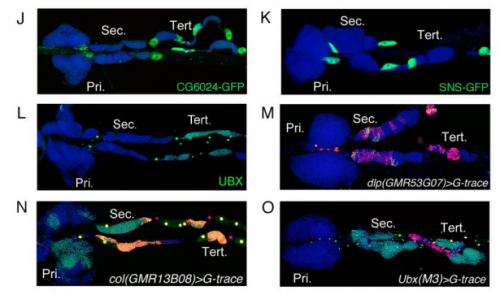
Differential activation of JAK-STAT signaling in blood cell progenitors reveals functional compartmentalization of the Drosophila lymph gland
Diana Rodrigues, Yoan Renaud, K. VijayRaghavan, Lucas Waltzer, Maneesha S. Inamdar
Dense reconstruction of elongated cell lineages: overcoming suboptimum lineage encoding and sparse cell sampling
Ken Sugino, Rosa L. Miyares, Isabel Espinosa-Medina, Hui-Min Chen, Christopher J Potter, Tzumin Lee
Non-apoptotic caspase activation sustains ovarian somatic stem cell functions by modulating Hedgehog-signalling and autophagy
Alessia Galasso, Daria Iakovleva, Luis Alberto Baena-Lopez
Widespread non-apoptotic activation of Drosophila Caspase-2/9 limits JNK signaling, macrophage proliferation, and growth of wound-like tumors
Derek Cui Xu, Kenneth M. Yamada, Luis Alberto Baena-Lopez
Ecdysone regulates the Drosophila imaginal disc epithelial barrier, determining the duration of regeneration checkpoint delay
Danielle DaCrema, Rajan Bhandari, Faith Karanja, Ryunosuke Yano, Adrian Halme
Twist regulates Yorkie to guide lineage reprogramming of syncytial alary muscles
Marcel Rose, Jakob Bartle-Schultheis, Katrin Domsch, Ingolf Reim, Christoph Schaub

Yorkie-independent negative feedback couples Hippo pathway activation with Kibra degradation
Sherzod A. Tokamov, Ting Su, Anne Ullyot, Richard G. Fehon
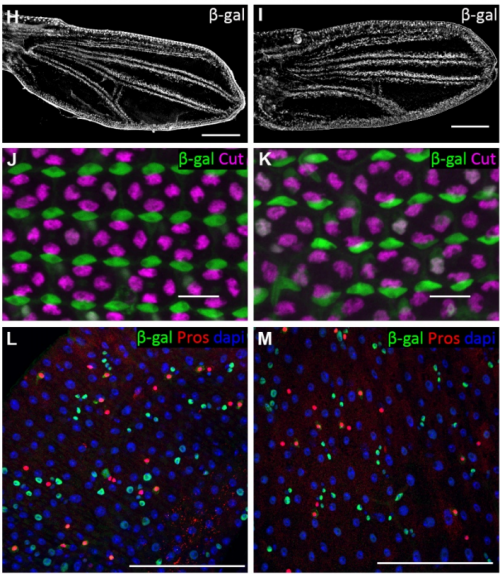
Enhancers with cooperative Notch binding sites are more resistant to regulation by the Hairless co-repressor
Yi Kuang, Anna Pyo, Natanel Eafergan, Brittany Cain, Lisa M. Gutzwiller, Ofri Axelrod, Ellen K. Gagliani, Matthew T. Weirauch, Raphael Kopan, Rhett A. Kovall, David Sprinzak, Brian Gebelein
JAK/STAT pathway promotes Drosophila neuroblast proliferation via the direct CycE regulation
Lijuan Du, Jian Wang
Raising the Connectome: the emergence of neuronal activity and behavior in Caenorhabditis elegans
Bradly Alicea
| Morphogenesis & mechanics
Deterministic and stochastic rules of branching govern dendritic morphogenesis of sensory neurons
Amrutha Palavalli, Nicolás Tizón-Escamilla, Jean-François Rupprecht, Thomas Lecuit
Epidermal PAR-6 and PKC-3 are essential for postembryonic development of Caenorhabditis elegans and control non-centrosomal microtubule organization
Victoria G. Castiglioni, Helena R. Pires, Rodrigo Rosas Bertolini, Amalia Riga, Jana Kerver, Mike Boxem
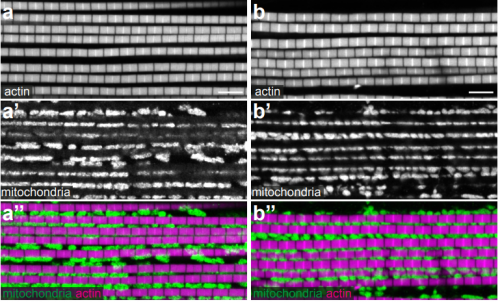
Myofibril and mitochondria morphogenesis are coordinated by a mechanical feedback mechanism in muscle
Jerome Avellaneda, Clement Rodier, Fabrice Daian, Thomas Rival, Nuno Miguel Luis, Frank Schnorrer
Basal epidermis collective migration and local Sonic hedgehog signaling promote skeletal branching morphogenesis in zebrafish fins
Joshua A. Braunstein, Amy E. Robbins, Scott Stewart, Kryn Stankunas
Cytokinetic abscission is part of the mid-blastula transition switch in early zebrafish embryogenesis
Shai Adar-Levor, Dikla Nachmias, Shani T. Gal-Oz, Yarden M. Jahn, Nadine Peyrieras, Assaf Zaritsky, Ramon Y. Birnbaum, Natalie Elia
The formin Fmn2 is required for the development of an excitatory interneuron module in the zebrafish acoustic startle circuit
Dhriti Nagar, Tomin K James, Ratnakar Mishra, Shrobona Guha, Aurnab Ghose
ARHGEF18/p114RhoGEF coordinates PKA/CREB signaling and actomyosin remodeling to drive trophoblast cell-cell fusion during placenta morphogenesis
Robert Beal, Ana Alonso-Carriazo Fernandez, Dimitris K. Grammatopoulos, Karl Matter, Maria S. Balda
DRAXIN regulates interhemispheric fissure remodelling to influence the extent of corpus callosum formation
Laura Morcom, Timothy J Edwards, Eric Rider, Dorothy Jones-Davis, Jonathan WC Lim, Kok-Siong Chen, Ryan Dean, Jens Bunt, Yunan Ye, llan Gobius, Rodrigo Suárez, Simone Mandelstam, Elliott H Sherr, Linda J Richards
Neural tube closure requires the endocytic receptor Lrp2 and its functional interaction with intracellular scaffolds
Izabela Kowalczyk, Chanjae Lee, Elisabeth Schuster, Josefine Hoeren, Valentina Trivigno, Levin Riedel, Jessica Görne, John B. Wallingford, Annette Hammes, Kerstin Feistel
Fibroblast fusion to the muscle fiber regulates myotendinous junction formation
Wesal Yaseen-Badarneh, Ortal Kraft-Sheleg, Shelly Zaffryar-Eilot, Shay Melamed, Chengyi Sun, Douglas P. Millay, Peleg Hasson
Gradual centriole maturation associates with the mitotic surveillance pathway in mouse development
Cally Xiao, Marta Grzonka, Charlotte Gerards, Miriam Mack, Rebecca Figge, Hisham Bazzi
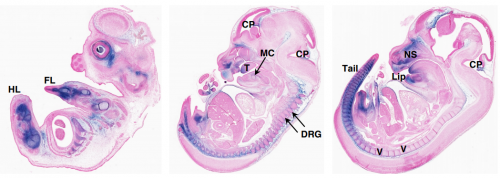
Knockout of the gene encoding the extracellular matrix protein SNED1 results in early neonatal lethality and craniofacial malformations
Anna Barqué, Kyleen Jan, Emanuel De La Fuente, Christina L. Nicholas, Richard O. Hynes, Alexandra Naba
PAK3 controls the tangential to radial migration switch of cortical interneurons by coordinating changes in cell shape and polarity
Lucie Viou, Pierre Launay, Véronique Rousseau, Justine Masson, Clarisse Pace, Robert S. Adelstein, X. Ma, Zhengping Jia, Fujio Murakami, Jean-Vianney Barnier, Christine Métin
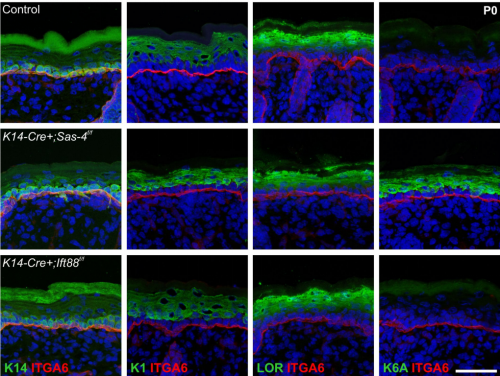
Epidermal stratification is uncoupled from centrosome-dependent cell division orientation of the basal progenitors
Mareike Damen, Ekaterina Soroka, Houda Khatif, Christian Kukat, Benjamin D. Simons, Hisham Bazzi
Interplay between medial nuclear stalling and lateral cellular flow underlies cochlear duct spiral morphogenesis
Mamoru Ishii, Tomoko Tateya, Michiyuki Matsuda, Tsuyoshi Hirashima
The effect of absent blood flow on the zebrafish cerebral and trunk vasculature
Elisabeth Kugler, Ryan Snodgrass, George Bowley, Karen Plant, Jovana Serbanovic-Canic, Paul C. Evans, Timothy Chico, Paul Armitage
Axon guidance at the midline – a live imaging perspective
Alexandre Dumoulin, Nikole R. Zuñiga, Esther T. Stoeckli
Drosophila USP22/non-stop regulates the Hippo pathway to polarise the actin cytoskeleton during collective border cell migration
Hammed Badmos, Neville Cobbe, Amy Campbell, Daimark Bennett
Astral microtubule crosslinking by Feo safeguards uniform nuclear distribution in the Drosophila syncytium
Ojas Deshpande, Jorge de-Carvalho, Diana V. Vieira, Ivo A. Telley
3D MAPs discovers the morphological sequence chondrocytes undergo in the growth plate and the regulatory role of GDF5 in this process
Sarah Rubin, Ankit Agrawal, Johannes Stegmaier, Jonathan Svorai, Yoseph Addadi, Paul Villoutreix, Tomer Stern, Elazar Zelzer
EHBP1 and EHD2 regulate Dll4 caveolin-mediated endocytosis during blood vessel development
Amelia M Webb, Caitlin R Francis, Jayson M Webb, Hayle Kincross, Keanna M Lundy, Rachael Judson, Dawn Westhoff, Stryder M Meadows, Erich J Kushner
Epithelial layer unjamming shifts energy metabolism toward glycolysis
Stephen J. DeCamp, Victor M.K. Tsuda, Jacopo Ferruzzi, Stephan A. Koehler, John T. Giblin, Darren Roblyer, Muhammad H. Zaman, Nicolas Chiu Ogassavara, Jennifer Mitchel, James P. Butler, Jeffrey J. Fredberg
Control and mechanisms of pulsatile flows in epithelial monolayers
Raghavan Thiagarajan, Alka Bhat, Guillaume Salbreux, Mandar M. Inamdar, Daniel Riveline
Cell cycle-dependent active stress drives epithelia remodeling
John Devany, Daniel M. Sussman, M. Lisa Manning, Margaret L. Gardel
| Genes & genomes
The First Mitotic Division of the Human Embryo is Highly Error-prone
Emma Ford, Cerys E. Currie, Deborah M. Taylor, Muriel Erent, Adele L. Marston, Geraldine M. Hartshorne, Andrew D. McAinsh
A spatially resolved single cell atlas of human gastrulation
Richard C.V. Tyser, Elmir Mahammadov, Shota Nakanoh, Ludovic Vallier, Antonio Scialdone, Shankar Srinivas
A single cell atlas of human cornea that defines its development, limbal stem and progenitor cells and the interactions with the limbal niche
Joseph Collin, Rachel Queen, Darin Zerti, Sanja Bojic, Nicky Moyse, Marina Moya Molina, Chunbo Yang, Gary Reynolds, Rafiqul Hussain, Jonathan M Coxhead, Steven Lisgo, Deborah Henderson, Agatha Joseph, Paul Rooney, Saurabh Ghosh, Che Connon, Muzlifah Haniffa, Francisco Figueiredo, Lyle Armstrong, Majlinda Lako
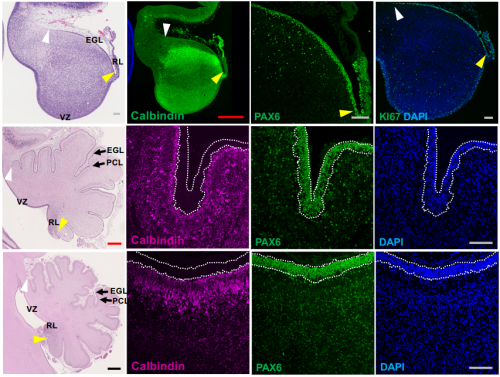
Spatial and single-cell transcriptional landscape of human cerebellar development
Kimberly A. Aldinger, Zach Thomson, Parthiv Haldipur, Mei Deng, Andrew E. Timms, Matthew Hirano, Gabriel Santpere, Charles Roco, Alexander B. Rosenberg, Belen Lorente-Galdos, Forrest O. Gulden, Diana O’Day, Lynne M. Overman, Steven N. Lisgo, Paula Alexandre, Nenad Sestan, Dan Doherty, William B. Dobyns, Georg Seelig, Ian A. Glass, Kathleen J. Millen
Single-cell sequencing of human iPSC-derived cerebellar organoids shows recapitulation of cerebellar development
Samuel Nayler, Devika Agarwal, Fabiola Curion, Rory Bowden, Esther B.E. Becker
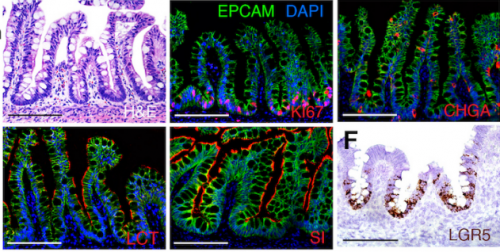
An organoid and multi-organ developmental cell atlas reveals multilineage fate specification in the human intestine
Qianhui Yu, Umut Kilik, Emily M. Holloway, Yu-Hwai Tsai, Angeline Wu, Joshua H. Wu, Michael Czerwinski, Charlie Childs, Zhisong He, Ian A. Glass, Peter D. R. Higgins, Barbara Treutlein, Jason R. Spence, J. Gray Camp
A semi-automated intestinal organoid screening method demonstrates epigenetic control of epithelial maturation
Jenny Ostrop, Rosalie Zwiggelaar, Marianne Terndrup Pedersen, François Gerbe, Korbinian Bösl, Håvard T. Lindholm, Alberto Díez-Sánchez, Naveen Parmar, Silke Radetzki, Jens Peter von Kries, Philippe Jay, Kim B. Jensen, Cheryl Arrowsmith, Menno J. Oudhoff
Unravelling the developmental roadmap towards human brown adipose tissue
Stefania Carobbio, Anne-Claire Guenantin, Myriam Bahri, Isabella Samuelson, Floris Honig, Sonia Rodriguez-Fdez, Kathleen Long, Ioannis Kamzolas, Sherine Awad, Dunja Lukovic, Slaven Erceg, Andrew Bassett, Sasha Mendjan, Ludovic Vallier, Barry S. Rosen, Davide Chiarugi, Antonio Vidal-Puig
The changing mouse embryo transcriptome at whole tissue and single-cell resolution
Peng He, Brian A. Williams, Diane Trout, Georgi K. Marinov, Henry Amrhein, Libera Berghella, Say-Tar Goh, Ingrid Plajzer-Frick, Veena Afzal, Len A. Pennacchio, Diane E. Dickel, Axel Visel, Bing Ren, Ross C. Hardison, Yu Zhang, Barbara J. Wold
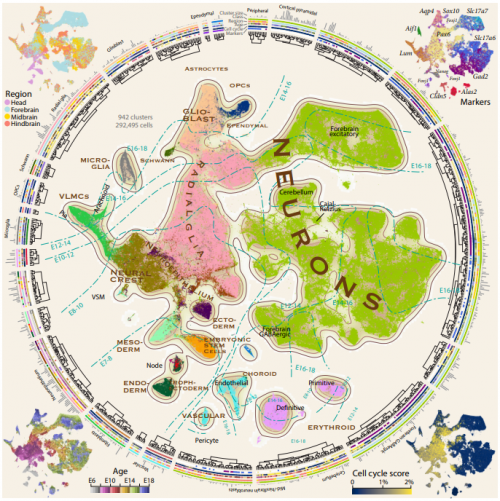
Molecular architecture of the developing mouse brain
Gioele La Manno, Kimberly Siletti, Alessandro Furlan, Daniel Gyllborg, Elin Vinsland, Christoffer Mattsson Langseth, Irina Khven, Anna Johnsson, Mats Nilsson, Peter Lönnerberg, Sten Linnarsson
Molecular Logic of Cellular Diversification in the Mammalian Cerebral Cortex
Daniela J. Di Bella, Ehsan Habibi, Sun-Ming Yang, Robert R. Stickels, Juliana Brown, Payman Yadollahpour, Fei Chen, Evan Z. Macosko, Aviv Regev, Paola Arlotta
Single-nucleus transcriptomics reveals functional compartmentalization in syncytial skeletal muscle cells
Minchul Kim, Vedran Franke, Bettina Brandt, Elijah D. Lowenstein, Verena Schöwel, Simone Spuler, Altuna Akalin, Carmen Birchmeier
Systematic investigation of imprinted gene expression and enrichment in the mouse brain explored at single-cell resolution
M. J. Higgs, M. J. Hill, R. M. John, A. R. Isles
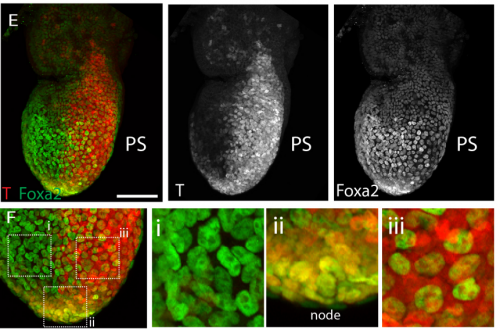
Ventricular, atrial and outflow tract heart progenitors arise from spatially and molecularly distinct regions of the primitive streak
Kenzo Ivanovitch, Pablo Soro-Barrio, Probir Chakravarty, Rebecca A Jones, S. Neda Mousavy Gharavy, Despina Stamataki, Julien Delile, James C Smith, James Briscoe
Chromatin topology and the timing of enhancer function at the hoxd locus
Eddie Rodríguez-Carballo, Lucille Lopez-Delisle, Andréa Willemin, Leonardo Beccari, Sandra Gitto, Bénédicte Mascrez, Denis Duboule
Subcellular mRNA localization and local translation of Arhgap11a in radial glial cells regulates cortical development
Louis-Jan Pilaz, Kaumudi Joshi, Jing Liu, Yuji Tsunekawa, Fernando C. Alsina, Sahil Sethi, Ikuo K. Suzuki, Pierre Vanderhaeghen, Franck Polleux, Debra L. Silver
RUNX1 marks a luminal castration resistant lineage established at the onset of prostate development
Renaud Mevel, Ivana Steiner, Susan Mason, Laura Galbraith, Rahima Patel, Muhammad ZH Fadlullah, Imran Ahmad, Hing Y. Leung, Pedro Oliveira, Karen Blyth, Esther Baena, Georges Lacaud
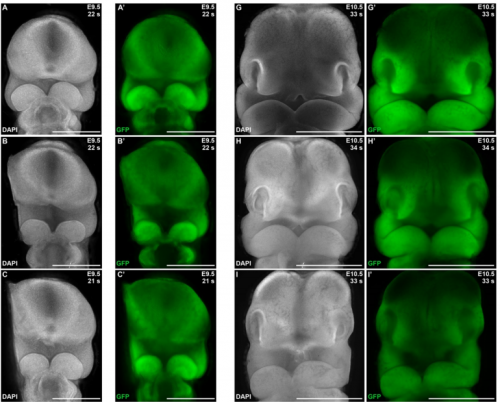
Pdgfra and Pdgfrb genetically interact in the murine neural crest cell lineage to regulate migration and proliferation
Julia Mo, Robert Long, Katherine A. Fantauzzo
Tet1 isoforms differentially regulate gene expression, synaptic transmission and memory in the mammalian brain
C.B. Greer, J. Wright, J.D. Weiss, R.M. Lazerenko, S.P. Moran, J. Zhu, K.S. Chronister, A.Y. Jin, A.J. Kennedy, J.D. Sweatt, G.A. Kaas
Laminin N-terminus α31 expression during development in an inducible-transgenic mouse model is lethal and causes a multitude of tissue-specific defects
Conor J. Sugden, Valentina Iorio, Lee D. Troughton, Ke Liu, George Bou-Gharios, Kevin J. Hamill
The long non-coding RNA Pax6os1/PAX6-AS1 modulates pancreatic β-cell identity and function
Livia Lopez-Noriega, Rebecca Callingham, Aida Martinez-Sánchez, Grazia Pizza, Nejc Haberman, Nevena Cvetesic, Boris Lenhard, Piero Marchetti, Lorenzo Piemonti, Eelco de Koning, A. M. James Shapiro, Paul R. Johnson, Isabelle Leclerc, Timothy J. Pullen, Guy A. Rutter
ESRP1-Mediated Alternative Splicing During Oocyte Development is Required for Mouse Fertility
Luping Yu, Huiru Zhang, Xuebing Guan, Dongdong Qin, Jian Zhou, Xin Wu
Polycomb-mediated Genome Architecture Enables Long-range Spreading of H3K27 methylation
Katerina Kraft, Kathryn E. Yost, Sedona Murphy, Andreas Magg, Yicheng Long, M.Ryan Corces, Jeffrey M. Granja, Stefan Mundlos, Thomas R. Cech, Alistair Boettiger, Howard Y. Chang
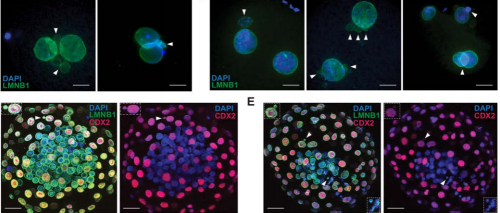
Genotypic Complexity in Initial Cleavage Divisions of Mammalian Embryos is Contributed by Defective BUB1B/BUBR1 Signaling
Kelsey E. Brooks, Brittany L. Daughtry, Brett Davis, Melissa Y. Yan, Suzanne S. Fei, Lucia Carbone, Shawn L. Chavez
Post-mitotic Prox1 expression controls the final specification of cortical VIP interneuron subtypes
Tevye Jason Stachniak, Rahel Kastli, Olivia Hanley, Ali Özgür Argunsah, Theofanis Karayannis
The Splicing Factor XAB2 interacts with ERCC1-XPF and XPG for RNA-loop processing during mammalian development
Evi Goulielmaki, Maria Tsekrekou, Nikos Batsiotos, Mariana Ascensão-Ferreira, Eleftheria Ledaki, Kalliopi Stratigi, Georgia Chatzinikolaou, Pantelis Topalis, Theodore Kosteas, Janine Altmüller, Jeroen A. Demmers, Nuno L. Barbosa-Morais, George A. Garinis
microRNAs (miR 9, 124, 155 and 224) transdifferentiate macrophages to neurons
Naveen Challagundla, Reena Agrawal-Rajput
miR6236, a microRNA suppressed by the anisotropic surface topography, regulates neuronal development and regeneration
Yi-Ju Chen, Yung-An Huang, Chris T. Ho, Jinn-Moon Yang, Jui-I Chao, Ming-Chia Li, Eric Hwang
Three Dimensional Multi-gene Expression Maps Reveal Cell Fate Changes Associated with Laterality Reversal of Zebrafish Habenula
Guo-Tzau Wang, He-Yen Pan, Wei-Han Lang, Yuan-Ding Yu, Chang-Huain Hsieh, Yung-Shu Kuan
Analysis of gene network bifurcation during optic cup morphogenesis in zebrafish
Lorena Buono, Silvia Naranjo, Tania Moreno-Marmol, Berta de la Cerda, Rocío Polvillo, Francisco-Javier Díaz-Corrales, Ozren Bogdanovic, Paola Bovolenta, Juan-Ramón Martínez-Morales
Overlapping and non-overlapping roles of the class-I histone deacetylase-1 corepressors, LET-418, SIN-3, and SPR-1 in Caenorhabditis elegans embryonic development
Yukihiro Kubota, Yuto Ohnishi, Tasuku Hamasaki, Gen Yasui, Natsumi Ota, Hiromu Kitagawa, Arashi Esaki, Muhamad Fahmi, Masahiro Ito
Single-Cell Protein Atlas of Transcription Factors Reveals the Combinatorial Code for Spatiotemporal Patterning the C. elegans Embryo
Xuehua Ma, Zhiguang Zhao, Long Xiao, Weina Xu, Yangyang Wang, Yanping Zhang, Gang Wu, Zhuo Du
Parallel genetics of regulatory sequences in vivo
Jonathan Froehlich, Bora Uyar, Margareta Herzog, Kathrin Theil, Petar Glažar, Altuna Akalin, Nikolaus Rajewsky
The pioneer factor GAF is essential for zygotic genome activation and chromatin accessibility in the early Drosophila embryo
Marissa M. Gaskill, Tyler J. Gibson, Elizabeth D. Larson, Melissa M. Harrison
A multi-informatic description of neural differentiation in the Drosophila type-II neuroblast lineages
Nigel S. Michki, Ye Li, Kayvon Sanjasaz, Yimeng Zhao, Fred Y. Shen, Logan A. Walker, Cheng-Yu Lee, Dawen Cai
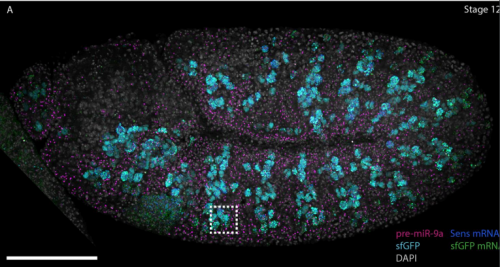
Single cell visualisation of mir-9a and Senseless co-expression during Drosophila melanogaster embryonic and larval peripheral nervous system development
Lorenzo Gallicchio, Sam Griffiths-Jones, Matthew Ronshaugen
RNA degradation sculpts the maternal transcriptome during Drosophila oogenesis
Patrick Blatt, Siu Wah Wong-Deyrup, Alicia McCarthy, Shane Breznak, Matthew D. Hurton, Maitreyi Upadhyay, Benjamin Bennink, Justin Camacho, Miler T. Lee, Prashanth Rangan
Drosophila p53 isoforms have overlapping and distinct functions in germline genome integrity and oocyte quality control
Ananya Chakravarti, Heshani N. Thirimanne, Brian R. Calvi
The Drosophila MOZ homolog Enok controls Notch-dependent induction of the RUNX gene lozenge independently of its histone-acetyl transferase activity
Thomas Genais, Delhia Gigan, Benoit Augé, Douaa Moussalem, Lucas Waltzer, Marc Haenlin, Vanessa Gobert
| Stem cells, regeneration & disease modelling
Hoxa10 mediates positional memory to govern stem cell function in adult skeletal muscle
Kiyoshi Yoshioka, Hiroshi Nagahisa, Fumihito Miura, Hiromitsu Araki, Yasutomi Kamei, Yasuo Kitajima, Daiki Seko, Jumpei Nogami, Yoshifumi Tsuchiya, Narihiro Okazaki, Akihiko Yonekura, Seigo Ohba, Yoshinori Sumita, Ko Chiba, Kosei Ito, Izumi Asahina, Yoshihiro Ogawa, Takashi Ito, Yasuyuki Ohkawa, Yusuke Ono
Mitochondrial STAT3 regulates proliferation of tissue stem cells
Margherita Peron, Giacomo Meneghetti, Alberto Dinarello, Laura Martorano, Riccardo M. Betto, Nicola Facchinello, Natascia Tiso, Graziano Martello, Francesco Argenton
Cullin3 promotes stem cell progeny differentiation by facilitating aPKC-directed asymmetric Numb localization
Hideyuki Komori, Noemi Rives-Quinto, Xu Han, Lucas Anhezini, Ari J. Esrig, James B. Skeath, Cheng-Yu Lee
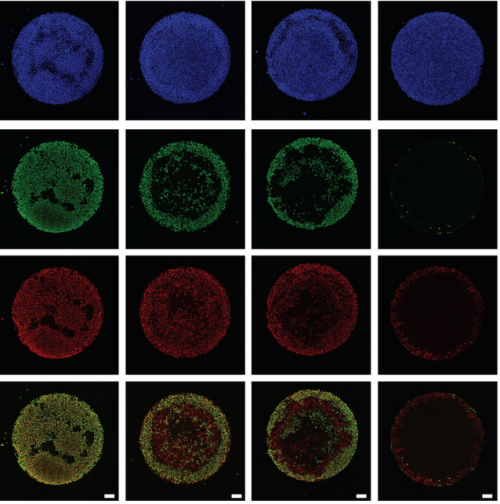
Endogenous suppression of WNT signalling in human embryonic stem cells leads to low differentiation propensity towards definitive endoderm
Dominika Dziedzicka, Mukul Tewary, Alexander Keller, Laurentijn Tilleman, Laura Prochazka, Joel Östblom, Edouard Couvreu De Deckersberg, Christina Markouli, Silvie Franck, Filip Van Nieuwerburgh, Claudia Spits, Peter W. Zandstra, Karen Sermon, Mieke Geens
Repopulating Kupffer Cells Originate Directly from Hematopoietic Stem Cells
Ying Jiang, Xu Fan, Pei Lu, Xianghua Cui, Peng Wu, Weiran Lin, Dong Zhang, Shongzong Yuan, Bing Liu, Fangyan Chen, Hong You, Handong Wei, Fuchu He, Jidong Jia
Capturing limbal epithelial stem cell population dynamics, signature, and their niche
Anna Altshuler, Aya Amitai-Lange, Noam Tarazi, Sunanda Dey, Lior Strinkovsky, Swarnabh Bhattacharya, Shira Hadad-Porat, Waseem Nasser, Jusuf Imeri, Gil Ben-David, Beatrice Tiosano, Eran Berkowitz, Nathan Karin, Yonatan Savir, Ruby Shalom-Feuerstein
NODAL/TGFβ signalling mediates the self-sustained stemness induced by PIK3CAH1047R homozygosity in pluripotent stem cells
Ralitsa R. Madsen, James Longden, Rachel G. Knox, Xavier Robin, Franziska Völlmy, Kenneth G. Macleod, Larissa S. Moniz, Neil O. Carragher, Rune Linding, Bart Vanhaesebroeck, Robert K. Semple
Ontogenic Shifts in Cellular Fate Are Linked to Proteotype Changes in Mouse Hematopoietic Progenitor Cells
Maria Jassinskaja, Kristýna Pimková, Emil Johansson, Ewa Sitnicka, Jenny Hansson
Dynamic spatiotemporal coordination of neural stem cell fate decisions through local feedback in the adult vertebrate brain
Nicolas Dray, Laure Mancini, Udi Binshtok, Felix Cheysson, Willy Supatto, Pierre Mahou, Sébastien Bedu, Sara Ortica, Monika Krecsmarik, Sébastien Herbert, Jean-Baptiste Masson, Jean-Yves Tinevez, Gabriel Lang, Emmanuel Beaurepaire, David Sprinzak, Laure Bally-Cuif
Phosphatidylinositol-3 kinase activity controls survival and stemness of zebrafish hematopoietic stem/progenitor cells
Sasja Blokzijl-Franke, Bas Ponsioen, Stefan Schulte-Merker, Philippe Herbomel, Karima Kissa, Suma Choorapoikayil, Jeroen den Hertog
Wnt- and Glutamate-receptors orchestrate stem cell dynamics and asymmetric cell division
Sergi Junyent, Joshua Reeves, James L. A. Szczerkowski, Clare L. Garcin, Tung-Jui Trieu, Matthew Wilson, Shukry J. Habib
Activation of a neural stem cell transcriptional program in parenchymal astrocytes
Jens P. Magnusson, Margherita Zamboni, Giuseppe Santopolo, Jeff E. Mold, Mauricio Barrientos-Somarribas, Carlos Talavera-López, Björn Andersson, Jonas Frisén
Loss of Nupr1 promotes engraftment by tuning the dormancy threshold of hematopoietic stem cell repository via regulating p53-checkpoint pathway
Tongjie Wang, Chengxiang Xia, Hui Cheng, Qitong Weng, Kaitao Wang, Yong Dong, Sha Hao, Fang Dong, Xiaofei Liu, Lijuan Liu, Yang Geng, Yuxian Guan, Juan Du, Tao Cheng, Jinyong Wang
Two DNA binding domains of Mga act in combination to suppress ectopic activation of meiosis-related genes in mouse embryonic stem cells
Kousuke Uranishi, Masataka Hirasaki, Yuka Kitamura, Yosuke Mizuno, Masazumi Nishimoto, Ayumu Suzuki, Akihiko Okuda
Mtg16-dependent repression of E protein activity is required for early lymphopoiesis
Pankaj Acharya, Shilpa Sampathi, David K. Flaherty, Brittany K. Matlock, Christopher S. Williams, Scott W. Hiebert, Kristy R. Stengel
Transcriptomic Profiling of Human Pluripotent Stem Cell-Derived Retinal Pigment Epithelium Over Time
Grace E. Lidgerwood, Anne Senabouth, Casey J.A. Smith-Anttila, Vikkitharan Gnanasambandapillai, Dominik C. Kaczorowski, Daniela Amann-Zalcenstein, Erica L. Fletcher, Shalin H. Naik, Alex W. Hewitt, Joseph E. Powell, Alice Pébay
High resolution mouse subventricular zone stem cell niche transcriptome reveals features of lineage, anatomy, and aging
Xuanhua P. Xie, Dan R. Laks, Daochun Sun, Asaf Poran, Ashley M. Laughney, Zilai Wang, Jessica Sam, German Belenguer, Isabel Fariñas, Olivier Elemento, Xiuping Zhou, Luis F. Parada
Long-term Reconstruction of Human Airway Epithelium-like Structure in Vivo with hESCs-derived organoid cells
Yong Chen, Le Han, Shanshan Zhao, Jianqi Feng, Lian Li, Zhili Rong, Ying Lin
Regeneration of Functional Retinal Ganglion Cells by Neuronal Identity Reprogramming
Xiaohu Wei, Zhenhao Zhang, Huan-huan Zeng, Xue-Feng Wang, Wenrong Zhan, Na Qiao, Zhen Chang, Lu Liu, Chengyu Fan, Ziwei Yang, Xiaoming Li, Yang Yang, Hongjun Liu
Primate heart regeneration via migration and fibroblast repulsion by human heart progenitors
Christine Schneider, Kylie S. Foo, Maria Teresa De Angelis, Gianluca Santamaria, Franziska Reiter, Tatjana Dorn, Andrea Bähr, Yat Long Tsoi, Petra Hoppmann, Ilaria My, Anna Meier, Victoria Jurisch, Nadja Hornaschewitz, Sascha Schwarz, Kun Lu, Roland Tomasi, Stefanie Sudhop, Elvira Parrotta, Marco Gaspari, Giovanni Cuda, Nikolai Klymiuk, Andreas Dendorfer, Markus Krane, Christian Kupatt, Daniel Sinnecker, Alessandra Moretti, Kenneth R. Chien, Karl-Ludwig Laugwitz
Neutrophil extracellular traps impair regeneration
Eric Wier, Mayumi Asada, Gaofeng Wang, Martin P. Alphonse, Ang Li, Chase Hintelmann, Christine Youn, Brittany Pielstick, Roger Ortines, Lloyd S. Miller, Nathan K. Archer, Luis A. Garza
Oral Regeneration Is the Default Pathway Triggered by Injury in Hydra
Jack Cazet, Celina Juliano
MAPK signaling links the injury response to Wnt-regulated patterning in Hydra regeneration
Anja Tursch, Natascha Bartsch, Thomas W. Holstein
Epigenetic immune-modulation by Histone Deacetylase Activity (HDAC) of tissue and organ regeneration in Xenopus laevis
Nathalia Pentagna, Felipe Soares dos Santos, Fernanda Martins de Almeida, José Garcia Abreu, Michael Levin, Katia Carneiro
TRANsCre-DIONE transdifferentiates scar-forming reactive astrocytes into functional motor neurons
Heeyoung An, Hye-Lan Lee, Doo-Wan Cho, Jinpyo Hong, Hye Yeong Lee, Jung Moo Lee, Junsung Woo, Jaekwang Lee, MinGu Park, Young-Su Yang, Su-Cheol Han, Yoon Ha, C. Justin Lee
Genome-Scale CRISPR Screening reveals novel factors regulating Wnt-dependent regeneration of mouse gastric organoids
Kazuhiro Murakami, Yumi Terakado, Kikue Saito, Yoshie Jomen, Haruna Takeda, Masanobu Oshima, Nick Barker
Mechanical overstimulation causes acute injury followed by fast recovery in lateral-line neuromasts of larval zebrafish
Melanie Holmgren, Michael E. Ravicz, Kenneth E. Hancock, Olga Strelkova, Artur A. Indzhykulian, Mark E. Warchol, Lavinia Sheets
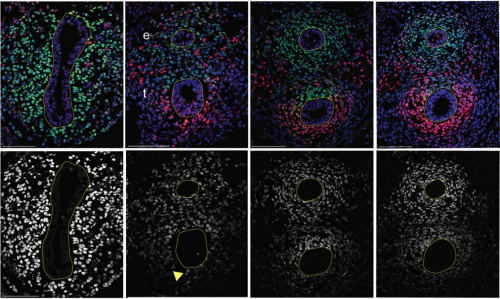
Disruption of a Hedgehog-Foxf1-Rspo2 Signaling Axis Leads to Tracheomalacia and a Loss of Sox9+ Tracheal Chondrocytes
Talia Nasr, Praneet Chaturvedi, Kunal Agarwal, Jessica L. Kinney, Keziah Daniels, Stephen L. Trisno, Vladimir Ustiyan, John M. Shannon, James M. Wells, Debora Sinner, Vladimir V. Kalinichenko, Aaron M. Zorn
Human iPSC-based neurodevelopmental models of globoid cell leukodystrophy uncover patient- and cell type-specific disease phenotypes
Elisabeth Mangiameli, Anna Cecchele, Francesco Morena, Francesca Sanvito, Vittoria Matafora, Angela Cattaneo, Lucrezia Della Volpe, Daniela Gnani, Marianna Paulis, Lucia Susani, Sabata Martino, Raffaella Di Micco, Angela Bachi, Angela Gritti
Altered vertebrae morphology and bone mineralization in a zebrafish model of CHARGE syndrome
Maximilian Breuer, Maximilian Rummler, Charlotte Zaouter, Bettina M. Willie, Shunmoogum A. Patten
Structural engraftment and topographic spacing of transplanted human stem cell-derived retinal ganglion cells
Kevin Y Zhang, Caitlyn Tuffy, Joseph L Mertz, Sarah Quillen, Laurence Wechsler, Harry A Quigley, Donald J Zack, Thomas V Johnson
Wide phenotypic spectrum of human stem cell-derived excitatory neurons with Rett syndrome-associated MECP2 mutations
Rebecca SF Mok, Wenbo Zhang, Taimoor I Sheikh, Isabella R Fernandes, Leah C DeJong, Matthew R Hildebrandt, Marat Mufteev, Deivid C Rodrigues, Wei Wei, Alina Piekna, Jiaje Liu, Alysson R Muotri, John B Vincent, Michael W Salter, James Ellis
Human embryonic stem cells-derived dopaminergic neurons transplanted in parkinsonian monkeys recover dopamine levels and motor behavior
Adolfo López-Ornelas, Itzel Escobedo-Avila, Gabriel Ramírez-García, Rolando Lara-Rodarte, César Meléndez-Ramírez, Beetsi Urrieta-Chávez, Tonatiuh Barrios-García, Verónica A. Cáceres-Chávez, Xóchitl Flores-Ponce, Francia Carmona, Carlos Alberto Reynoso, Carlos Aguilar, Nora E. Kerik, Luisa Rocha, Leticia Verdugo-Díaz, Víctor Treviño, José Bargas, Verónica Ramos-Mejía, Juan Fernández-Ruiz, Aurelio Campos-Romo, Iván Velasco
Autism-linked Cullin3 germline haploinsufficiency impacts cytoskeletal dynamics and cortical neurogenesis through RhoA signaling
Megha Amar, Akula Bala Pramod, Nam-Kyung Yu, Victor Munive Herrera, Lily R. Qiu, Patricia Moran-Losada, Pan Zhang, Cleber A. Trujillo, Jacob Ellegood, Jorge Urresti, Kevin Chau, Jolene Diedrich, Jiaye Chen, Jessica Gutierrez, Jonathan Sebat, Dhakshin Ramanathan, Jason P. Lerch, John R. Yates III, Alysson R. Muotri, Lilia M. Iakoucheva
Neurodegeneration induces a developmental RNA processing program by calpain-mediated MBNL2 degradation
Lee-Hsin Wang, Yu-Mei Lin, Chien-Yu Lin, Yijuang Chern, Guey-Shin Wang
Assessment of autism zebrafish mutant models using a high-throughput larval phenotyping platform
Alexandra Colón-Rodríguez, José M. Uribe-Salazar, KaeChandra B. Weyenberg, Aditya Sriram, Alejandra Quezada, Gulhan Kaya, Emily Jao, Brittany Radke, Pamela J. Lein, Megan Y. Dennis
A zebrafish model of Granulin deficiency reveals essential roles in myeloid cell differentiation
Clyde A. Campbell, Oksana Fursova, Xiaoyi Cheng, Elizabeth Snella, Abbigail McCune, Liangdao Li, Barbara Solchenberger, Bettina Schmid, Debashis Sahoo, Mark Morton, David Traver, Raquel Espín-Palazón
RHEB/mTOR-hyperactivity causing cortical malformations drives seizures through increased axonal connectivity
Martina Proietti Onori, Linda M.C. Koene, Carmen B. Schafer, Mark Nellist, Marcel de Brito van Velze, Zhenyu Gao, Ype Elgersma, Geeske M. van Woerden
| Plant development
Altered stomatal patterning accompanies a trichome dimorphism in a natural population of Arabidopsis
Noriane M. L. Simon, Jiro Sugisaka, Mie N. Honjo, Sverre Aarseth Tunstad, George Tunna, Hiroshi Kudoh, Antony N. Dodd
Precise transcriptional control of cellular quiescence by BRAVO/WOX5 complex in Arabidopsis roots
Isabel Betegón-Putze, Josep Mercadal, Nadja Bosch, Ainoa Planas-Riverola, Mar Marquès-Bueno, Josep Vilarrasa-Blasi, David Frigola, Rebecca Corinna Burkart, Cristina Martínez, Yvonne Stahl, Salomé Prat, Marta Ibañes, Ana I. Caño-Delgado
Expansin-controlled cell wall stiffness regulates root growth in Arabidopsis
Marketa Samalova, Kareem Elsayad, Alesia Melnikava, Alexis Peaucelle, Evelina Gahurova, Jaromir Gumulec, Ioannis Spyroglou, Elena V. Zemlyanskaya, Elena V. Ubogoeva, Jan Hejatko
Root electrotropism in Arabidopsis does not depend on auxin distribution, requires cytokinin biosynthesis and follows a power-law response curve
Nicholas Oliver, Maddalena Salvalaio, Deniz Tiknaz, Maximillian Schwarze, Nicolas Kral, Soo-Jeong Kim, Giovanni Sena
The IncRNA APOLO interacts with the transcription factor WRKY42 to trigger root hair cell expansion in response to cold
Michaël Moison, Javier Martínez Pacheco, Leandro Lucero, Camille Fonouni-Farde, Johan Rodríguez-Melo, Aurélie Christ, Jérémie Bazin, Moussa Benhamed, Fernando Ibañez, Martin Crespi, José M. Estevez, Federico Ariel
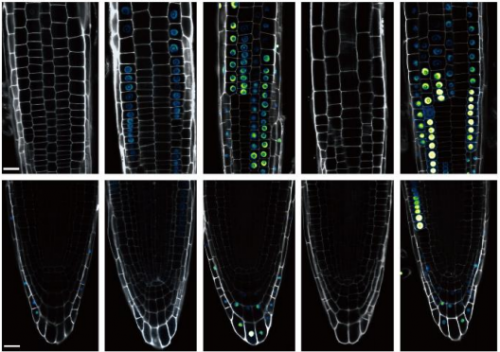
ABCB-mediated auxin transport in outer root tissues regulates lateral root spacing in Arabidopsis
Jian Chen, Yangjie Hu, Pengchao Hao, Yuqin Zhang, Ohad Roth, Maria F. Njo, Lieven Sterck, Yun Hu, Yunde Zhao, Markus Geisler, Eilon Shani, Tom Beeckman, Steffen Vanneste
The PIF1-MIR408-Plantacyanin Repression Cascade Regulates Light Dependent Seed Germination
Anlong Jiang, Zhonglong Guo, Jiawei Pan, Yan Zhuang, Daqing Zuo, Chen Hao, Zhaoxu Gao, Peiyong Xin, Jinfang Chu, Shangwei Zhong, Lei Li
Temperature-dependent fasciation mutants connect mitochondrial RNA processing to the control of cell proliferation during lateral root morphogenesis
Kurataka Otsuka, Akihito Mamiya, Mineko Konishi, Mamoru Nozaki, Atsuko Kinoshita, Hiroaki Tamaki, Masaki Arita, Masato Saito, Kayoko Yamamoto, Takushi Hachiya, Ko Noguchi, Takashi Ueda, Yusuke Yagi, Takehito Kobayashi, Takahiro Nakamura, Yasushi Sato, Takashi Hirayama, Munetaka Sugiyama
High-resolution temporal transcript profiling during Arabidopsis thaliana gynoecium morphogenesis uncovers the chronology of gene regulatory network activity and reveals novel developmental regulators
Kimmo I. Kivivirta, Denise Herbert, Clemens Roessner, Stefan de Folter, Nayelli Marsch-Martinez, Annette Becker
Developmental constraints modulate reproductive fate and plasticity within the Arabidopsis ovule primordium
Elvira Hernandez-Lagana, Gabriella Mosca, Ethel Mendocilla Sato, Nuno Pires, Anja Frey, Alejandro Giraldo-Fonseca, Ueli Grossniklaus, Olivier Hamant, Christophe Godin, Arezki Boudaoud, Daniel Grimanelli, Daphné Autran, Célia Baroux
SUMOylation contributes to proteostasis of the chloroplast protein import receptor TOC159 during early development
Sonia Accossato, Felix Kessler, Venkatasalam Shanmugabalaji
The impact of chromatin remodeling on gene expression at the single cell level in Arabidopsis thaliana
Andrew Farmer, Sandra Thibivilliers, Kook Hui Ryu, John Schiefelbein, Marc Libault
H3.1K27me1 maintains transcriptional silencing and genome stability by preventing GCN5-mediated histone acetylation
Jie Dong, Chantal LeBlanc, Axel Poulet, Benoit Mermaz, Gonzalo Villarino, Kimberly M. Webb, Valentin Joly, Josefina Mendez, Philipp Voigt, Yannick Jacob
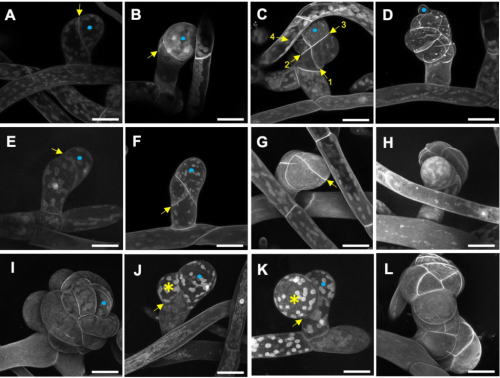
NO GAMETOPHORES 2 is a novel regulator of the 2D to 3D growth transition in the moss Physcomitrium patens
Laura A. Moody, Steven Kelly, Roxaana Clayton, Zoe Weeks, David M. Emms, Jane A. Langdale
Underground gibberellin activity: differential gibberellin response in tomato shoots and roots
Uria Ramon, David Weiss, Natanella Illouz-Eliaz
Phytochromes B1/B2 are major regulators of ripening-associated epigenome reprogramming in tomato fruits
Ricardo Bianchetti, Nicolas Bellora, Luis A de Haro, Rafael Zuccarelli, Daniele Rosado, Luciano Freschi, Magdalena Rossi, Luisa Bermudez
Organogenesis and Vasculature of Anaxagorea and its Implications in the Integrated Axial-Foliar Origin of the Angiosperm Carpel
Ya Li, Wei Du, Shuai Wang, Xiao-Fan Wang
Fruit presence induces polar auxin transport in citrus and olive stem and represses hormone release from the bud
Dor Haim, Liron Shalom, Yasmin Simhon, Lyudmila Shlizerman, Itzhak Kamara, Michael Morozov, Alfonso Ant Albacete Moreo, Rosa M Rivero, Avi Sadka
Fine tuning of hormonal signaling is linked to dormancy status in sweet cherry flower buds
Noémie Vimont, Adrian Schwarzenberg, Mirela Domijan, Armel S. L. Donkpegan, Rémi Beauvieux, Loïck le Dantec, Mustapha Arkoun, Frank Jamois, Jean-Claude Yvin, Philip A. Wig
INTERMEDIUM-C mediates the shade-induced bud growth arrest in barley
Hongwen Wang, Christiane Seiler, Nese Sreenivasulu, Nicolaus von Wirén, Markus Kuhlmann
Evo-devo & evo
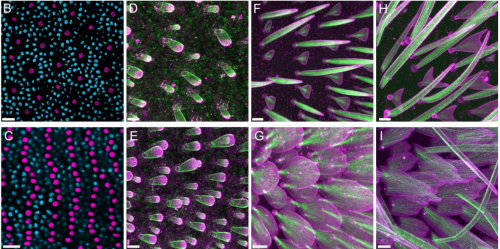
Developmental, cellular, and biochemical basis of transparency in the glasswing butterfly Greta oto
Aaron F. Pomerantz, Radwanul H. Siddique, Elizabeth I. Cash, Yuriko Kishi, Charline Pinna, Kasia Hammar, Doris Gomez, Marianne Elias, Nipam H. Patel
Acoel single-cell transcriptomics: cell-type analysis of a deep branching bilaterian
Jules Duruz, Cyrielle Kaltenrieder, Peter Ladurner, Rémy Bruggmann, Pedro Martìnez, Simon G. Sprecher
Muscle cell type diversification facilitated by extensive gene duplications
Alison G. Cole, Sabrina Kaul, Stefan M. Jahnel, Julia Steger, Bob Zimmerman, Robert Reischl, Gemma Sian Richards, Fabian Rentzsch, Patrick Steinmetz, Ulrich Technau
Embryonic origin and serial homology of gill arches and paired fins in the skate (Leucoraja erinacea)
Victoria A. Sleight, J. Andrew Gillis
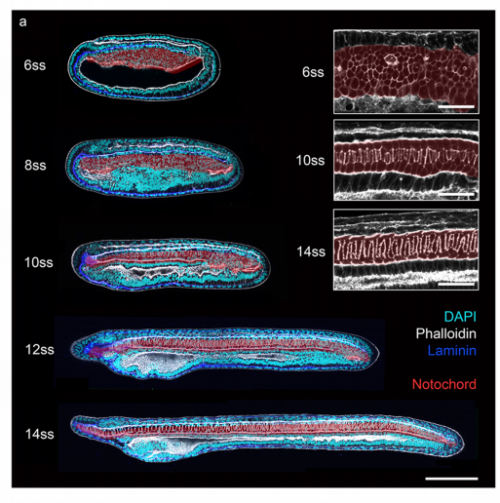
Single-cell morphometrics reveals ancestral principles of notochord development
Toby G R Andrews, Wolfram Pönisch, Ewa Paluch, Benjamin J Steventon, Elia Benito-Gutierrez
The evolution of Sox gene repertoires and regulation of segmentation in arachnids
Luis Baudouin-Gonzalez, Anna Schoenauer, Amber Harper, Grace Blakeley, Michael Seiter, Saad Arif, Lauren Sumner-Rooney, Steven Russell, Prashant P. Sharma, Alistair P. McGregor
Widespread retention of ohnologs in key developmental gene families following whole genome duplication in arachnopulmonates
Amber Harper, Luis Baudouin Gonzalez, Anna Schönauer, Michael Seiter, Michaela Holzem, Saad Arif, Alistair P. McGregor, Lauren Sumner-Rooney
The developmental and genetic architecture of the sexually selected male ornament of swordtails
Manfred Schartl, Susanne Kneitz, Jenny Ormanns, Cornelia Schmidt, Jennifer L Anderson, Angel Amores, Julian Catchen, Catherine Wilson, Dietmar Geiger, Kang Du, Mateo Garcia-Olazábal, Sudha Sudaram, Christoph Winkler, Rainer Hedrich, Wesley C Warren, Ronald Walter, Axel Meyer, John H Postlethwait
An early cell shape transition drives evolutionary expansion of the human forebrain
Silvia Benito-Kwiecinski, Stefano L. Giandomenico, Magdalena Sutcliffe, Erlend S. Riis, Paula Freire-Pritchett, Iva Kelava, Stephanie Wunderlich, Ulrich Martin, Greg Wray, Madeline A. Lancaster
Mitochondrial state determines functionally divergent stem cell population in planaria
Mohamed Mohamed Haroon, Vairavan Lakshmanan, Souradeep R. Sarkar, Kai Lei, Praveen Kumar Vemula, Dasaradhi Palakodeti
The essential role of Dnmt1 in gametogenesis in the large milkweed bug Oncopeltus fasciatus
Joshua T. Washington, Katelyn R. Cavender, Ashley U. Amukamara, Elizabeth C. McKinney, Robert J. Schmitz, Patricia J. Moore
The direct regulation of Aalbdsx on AalVgR is indispensable for ovarian development in Aedes albopictus
Binbin Jin, Yijie Zhao, Peiwen Liu, Yan Sun, Xiaocong Li, Xin Zhang, Xiao-Guang Chen, Jinbao Gu
Differences in developmental potential predict the contrasting patterns of dental diversification in characiform and cypriniform fishes
David Jandzik, David W Stock
Evolution of regulatory signatures in primate cortical neurons at cell type resolution
Alexey Kozlenkov, Marit W. Vermunt, Pasha Apontes, Junhao Li, Ke Hao, Chet C. Sherwood, Patrick R. Hof, John J. Ely, Michael Wegner, Eran A. Mukamel, Menno P. Creyghton, Eugene V. Koonin, Stella Dracheva
Testing for a role of Dnmt2 in paternal trans-generational immune priming
Nora K E Schulz, Maike F Diddens-de Buhr, Joachim Kurtz
Balancing selection maintains ancient genetic diversity in C. elegans
Daehan Lee, Stefan Zdraljevic, Lewis Stevens, Ye Wang, Robyn E. Tanny, Timothy A. Crombie, Daniel E. Cook, Amy K. Webster, Rojin Chirakar, L. Ryan Baugh, Mark G. Sterken, Christian Braendle, Marie-Anne Félix, Matthew V. Rockman, Erik C. Andersen
Inferring the genetic basis of sex determination from the genome of a dioecious nightshade
Meng Wu, Gregory J. Anderson, Matthew W. Hahn, Leonie C. Moyle, Rafael F. Guerrero
Lack of support for Deuterostomia prompts reinterpretation of the first Bilateria
Paschalia Kapli, Paschalis Natsidis, Daniel J. Leite, Maximilian Fursman, Nadia Jeffrie, Imran A. Rahman, Hervé Philippe, Richard R. Copley, Maximilian J. Telford
Cell biology
Sister chromatid repair maintains genomic integrity during meiosis in Caenorhabditis elegans
Erik Toraason, Cordell Clark, Anna Horacek, Marissa L. Glover, Alina Salagean, Diana E. Libuda
Meiotic sister chromatid exchanges are rare in C. elegans
David E. Almanzar, Spencer G. Gordon, Ofer Rog
The Nesprin-1/-2 ortholog ANC-1 regulates organelle positioning in C. elegans without its KASH or actin-binding domains
Hongyan Hao, Shilpi Kalra, Laura E. Jameson, Leslie A. Guerrero, Natalie E. Cain, Jessica Bolivar, Daniel A. Starr
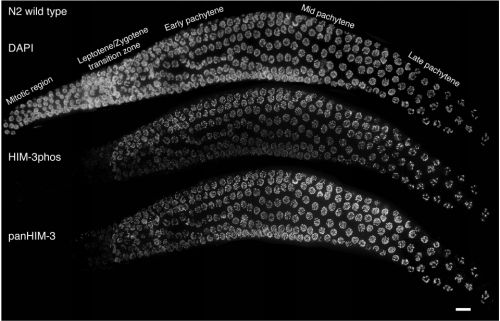
Phosphoregulation of HORMA domain protein HIM-3 promotes asymmetric synaptonemal complex disassembly in meiotic prophase in C. elegans
Aya Sato-Carlton, Chihiro Nakamura-Tabuchi, Xuan Li, Hendrik Boog, Madison K Lehmer, Scott C Rosenberg, Consuelo Barroso, Enrique Martinez-Perez, Kevin D Corbett, Peter Mark Carlton
FLN-1/Filamin is required to anchor the actomyosin cytoskeleton and for global organization of sub-cellular organelles in a contractile tissue
Charlotte A. Kelley, Olivia Triplett, Samyukta Mallick, Kristopher Burkewitz, William B. Mair, Erin J. Cram
Long-term live imaging of epithelial organoids and corresponding multiscale analysis reveal high heterogeneity and identify core regulatory principles
Lotta Hof, Till Moreth, Michael Koch, Tim Liebisch, Marina Kurtz, Julia Tarnick, Susanna M. Lissek, Monique M.A. Verstegen, Luc J.W. van der Laan, Meritxell Huch, Franziska Matthäus, Ernst H.K. Stelzer, Francesco Pampaloni
Combinatorial deployment of F-actin regulators to build complex 3D actin structures in vivo
Yi Xie, J. Todd Blankenship
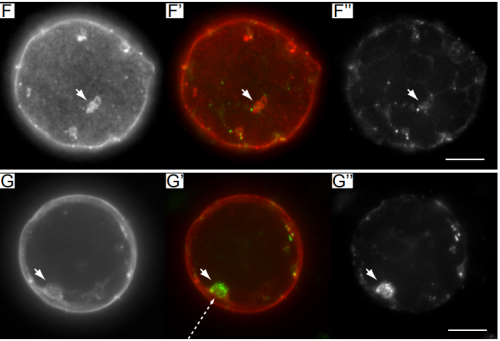
The Drosophila EGFR ligand mSpitz is delivered to cytoplasmic capes at sites of non-canonical RNA export on the nuclear envelope via the endosomal system
Floyd J. Mattie, Praveen Kumar, Mark D. Travor, Kristen C. Browder, Claire M. Thomas
RhoA effectors LOK/SLK activate ERM proteins to locally inhibit RhoA and define apical morphology
Riasat Zaman, Andrew Lombardo, Cécile Sauvanet, Raghuvir Viswanatha, Valerie Awad, Locke Ezra-Ros Bonomo, David McDermitt, Anthony Bretscher
Time-resolved proteomic profiling of the ciliary Hedgehog response reveals that GPR161 and PKA undergo regulated co-exit from cilia
Elena A. May, Marian Kalocsay, Inès Galtier D’Auriac, Steven P. Gygi, Maxence V. Nachury, David U. Mick
Lamin C regulates genome organization after mitosis
X Wong, VE Hoskins, JC Harr, M Gordon, KL Reddy
Microtubules tune mechanosensitive cell responses
Shailaja Seetharaman, Benoit Vianay, Vanessa Roca, Chiara De Pascalis, Batiste Boëda, Florent Dingli, Damarys Loew, Stéphane Vassilopoulos, Manuel Théry, Sandrine Etienne-Manneville
Identification of a new regulation pathway of EGFR and E-cadherin dynamics
Veronique Proux-Gillardeaux, Tamara Advedissian, Charlotte Perin, Jean-Christophe Gelly, Mireille Viguier, Fredérique Deshayes
Modelling
Computational modelling unveils how epiblast remodelling and positioning rely on trophectoderm morphogenesis during mouse implantation
Joel Dokmegang, Moi Hoon Yap, Liangxiu Han, Matteo Cavaliere, René Doursat
Geometric models for robust encoding of dynamical information into embryonic patterns
Laurent Jutras-Dubé, Ezzat El-Sherif, Paul François
Cell-scale biophysical determinants of cell competition in epithelia
Daniel Gradeci, Anna Bove, Giulia Vallardi, Alan R. Lowe, Shiladitya Banerjee, Guillaume Charras
Size-regulated symmetry breaking in reaction-diffusion models of developmental transitions
Jake Cornwall Scoones, Deb Sankar Banerjee, Shiladitya Banerjee
A deep reinforcement learning model based on deterministic policy gradient for collective neural crest cell migration
Yihao Zhang, Zhaojie Chai, Yubing Sun, George Lykotrafitis
A hybrid discrete-continuum approach to model Turing pattern formation
Fiona R Macfarlane, Mark AJ Chaplain, Tommaso Lorenzi
Lineage optimization in nematode’s early embryogenesis
Guoye Guan, Ming-Kin Wong, Zhongying Zhao, Lei-Han Tang, Chao Tang
Modelling cellular signalling variability based on single-cell data: the TGFb/SMAD signaling pathway
Uddipan Sarma, Lorenz Hexemer, Uchenna Alex Anyaegbunam, Stefan Legewie
A free boundary mechanobiological model of epithelial tissues
Tamara A. Tambyah, Ryan J. Murphy, Pascal R. Buenzli, Matthew J. Simpson
Tools & resources
A new species of planarian flatworm from Mexico: Girardia guanajuatiensis
Elizabeth M. Duncan, Stephanie H. Nowotarski, Carlos Guerrero-Hernández, Eric J. Ross, Julia A. D’Orazio, Clubes de Ciencia México Workshop for Developmental Biology, Sean McKinney, Longhua Guo, Alejandro Sánchez Alvarado
Application of CRISPR/Cas9 nuclease in amphioxus genome editing
Liuru Su, Chenggang Shi, Xin Huang, Yiquan Wang, Guang Li
Lineage recording of zebrafish embryogenesis reveals historical and ongoing lineage commitments
Zhuoxin Chen, Chang Ye, Zhan Liu, Shanjun Deng, Xionglei He, Jin Xu
Endogenous zebrafish proneural Cre drivers generated by CRISPR/Cas9 short homology directed targeted integration
Maira P. Almeida, Jordan M. Welker, Stephen C. Ekker, Karl J. Clark, Jeffrey J. Essner, Maura McGrail
A CRISPR/Cas9 vector system for neutrophil-specific gene disruption in zebrafish
Yueyang Wang, Alan Y. Hsu, Eric M. Walton, Ramizah Syahirah, Tianqi Wang, Wenqing Zhou, Chang Ding, Abby Pei Lemke, David M. Tobin, Qing Deng
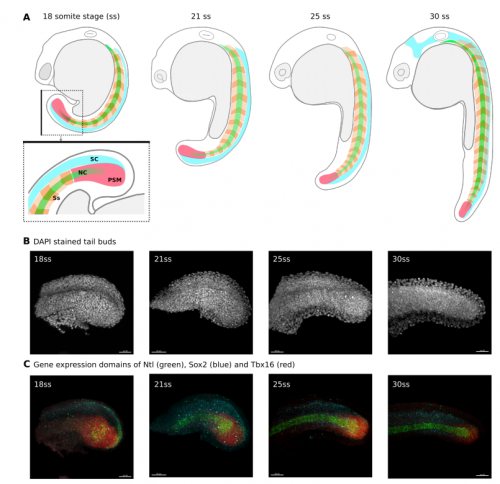
A deep learning approach for staging embryonic tissue isolates with small data
Adam Pond, Seongwon Hwang, Berta Verd, Benjamin Steventon
Dehydrated Caenorhabditis elegans stocks are resistant to multiple freeze-thaw cycles
Patrick D. McClanahan, Richard J. McCloskey, Melanie N. T. Hing, David M. Raizen, Christopher Fang-Yen
Adaptable and Efficient Genome Editing by sgRNA-Cas9 Protein Co-injection into Drosophila
Kevin G. Nyberg, Joseph Q. Nguyen, Yong-Jae Kwon, Shelby Blythe, Greg J. Beitel, Richard W. Carthew
AggreCount: An unbiased image analysis tool for identifying and quantifying cellular aggregates in a spatial manner
Jacob Aaron Klickstein, Sirisha Mukkavalli, Malavika Raman
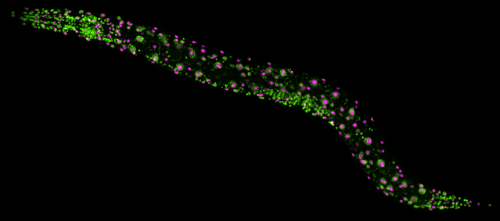
Split-wrmScarlet and split-sfGFP: tools for faster, easier fluorescent labeling of endogenous proteins in Caenorhabditis elegans
Jérôme Goudeau, Jonathan Paw, Laura Savy, Manuel D. Leonetti, Andrew G. York, Cynthia Kenyon, Maria Ingaramo
Segmentation of the Zebrafish Brain Vasculature from Light Sheet Fluorescence Microscopy Datasets
Elisabeth C. Kugler, Andrik Rampun, Timothy J.A. Chico, Paul A. Armitage
Fluorescent in vivo editing reporter (FIVER): A novel multispectral reporter of in vivo genome editing
Peter A. Tennant, Robert G. Foster, Daniel O. Dodd, Ieng Fong Sou, Fraser McPhie, Nicholas Younger, Laura C. Murphy, Matthew Pearson, Bertrand Vernay, Margaret A. Keighren, Peter Budd, Stephen L. Hart, Roly Megaw, Luke Boulter, Pleasantine Mill
Rosa26 docking sites for investigating genetic circuit silencing in stem cells
Michael Fitzgerald, Mark Livingston, Chelsea Gibbs, Tara L. Deans
Upgraded CRISPR/Cas9 Tools for Tissue-Specific Mutagenesis in Drosophila
Gabriel T. Koreman, Qinan Hu, Yineng Xu, Zijing Zhang, Sarah E. Allen, Mariana F. Wolfner, Bei Wang, Chun Han
NeuroPAL: A Neuronal Polychromatic Atlas of Landmarks for Whole-Brain Imaging in C. elegans
Eviatar Yemini, Albert Lin, Amin Nejatbakhsh, Erdem Varol, Ruoxi Sun, Gonzalo E. Mena, Aravinthan D.T. Samuel, Liam Paninski, Vivek Venkatachalam, Oliver Hobert
A simple and highly efficient method for multi-allelic CRISPR-Cas9 editing in primary cell cultures
Pia Hoellerbauer, Megan Kufeld, Sonali Arora, Hua-Jun Wu, Heather M. Feldman, Patrick J. Paddison
Research practice & education
Gender, race and parenthood impact academic productivity during the COVID-19 pandemic: from survey to action
Fernanda Staniscuaski, Livia Kmetzsch, Eugenia Zandonà, Fernanda Reichert, Rossana C. Soletti, Zelia M.C Ludwig, Eliade F. Lima, Adriana Neumann, Ida V.D. Schwartz, Pamela B. Mello-Carpes, Alessandra S.K. Tamajusuku, Fernanda P. Werneck, Felipe K. Ricachenevsky, Camila Infanger, Adriana Seixas, Charley C. Staats, Leticia de Oliveira
Advancing science or advancing careers? Researchers’ opinions on success indicators
Noémie Aubert Bonn, Wim Pinxten
An integrated, modular approach to data science education in the life sciences
Kimberly A Dill-McFarland, Stephan G König, Florent Mazel, David Oliver, Lisa M McEwen, Kris Y Hong, Steven J Hallam
Examining gender imbalance in chemistry authorship
Adam D. Cotton, Ian B. Seiple
Only two out of five articles by New Zealand researchers are free-to-access: a multiple API study of access, its impact on open citation advantage, cost of Article Processing Charges (APC), and the potential to increase the proportion of open access
Richard Kenneth Alistair White, Anton Angelo, Deborah Jane Fitchett, Moira Fraser, Luqman Hayes, Jess Howie, Emma Richardson, Bruce Duncan White
A Multi-perspective Analysis of Retractions in Life Sciences
Bhumika Bhatt


 (No Ratings Yet)
(No Ratings Yet)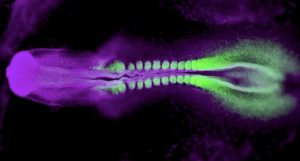
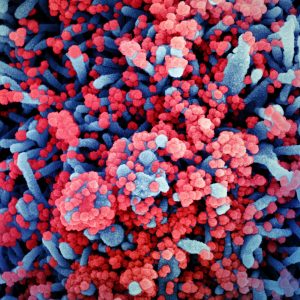 In the latest episode of Genetics Unzipped, Kat Arney looks at the ancient war between our genes and the pathogens that infect us, going back thousands of years to the Black Death and before, through to our very latest foe: the SARS-CoV-2 coronavirus behind COVID-19.
In the latest episode of Genetics Unzipped, Kat Arney looks at the ancient war between our genes and the pathogens that infect us, going back thousands of years to the Black Death and before, through to our very latest foe: the SARS-CoV-2 coronavirus behind COVID-19.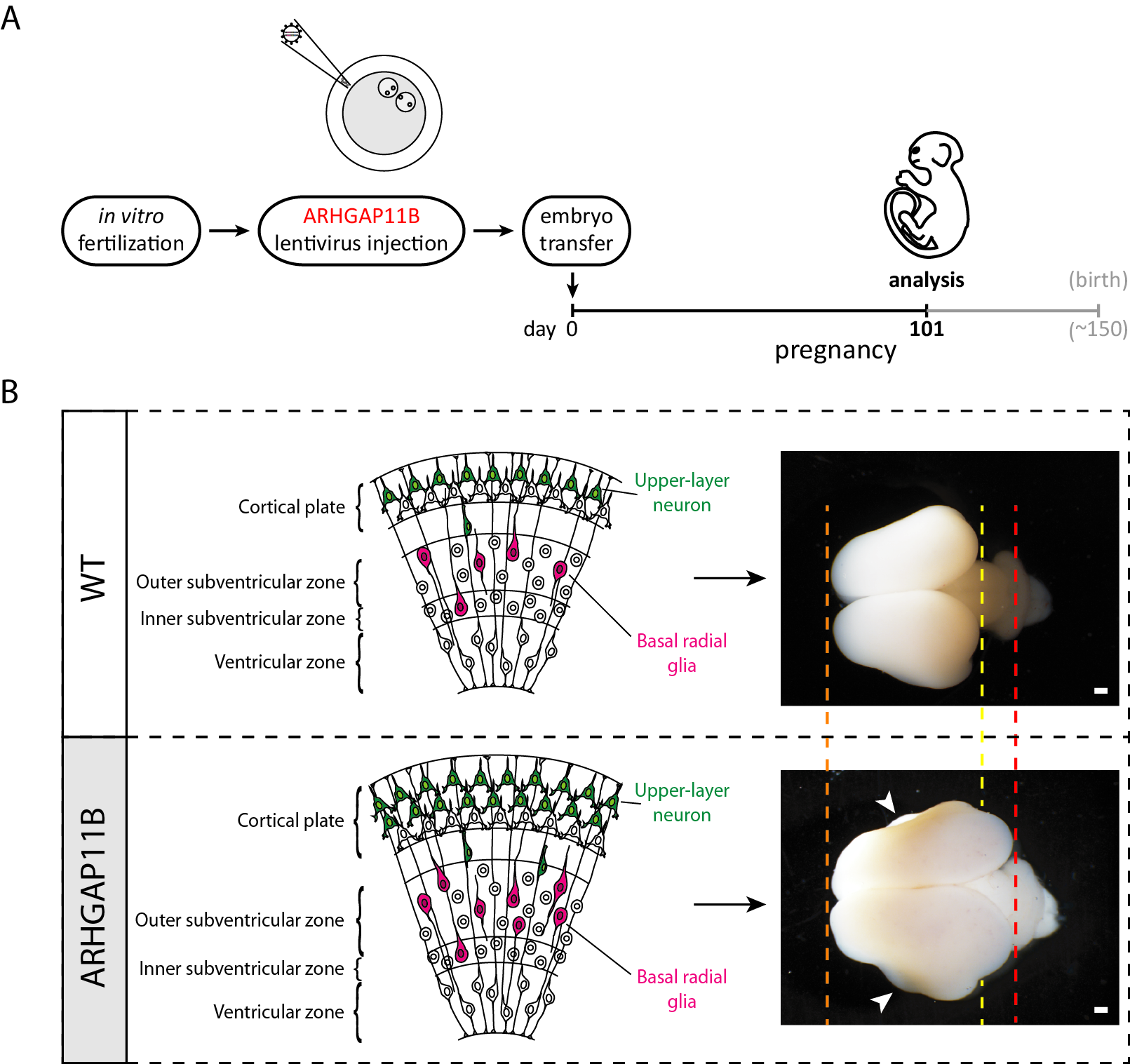
 (9 votes)
(9 votes)

 (2 votes)
(2 votes)